GemTek Technology M900821 Wireless LAN Mini PCI Card User Manual Manual
Gemtek Technology Co., Ltd. Wireless LAN Mini PCI Card Manual
Manual

11Mbps Wireless LAN Mini-PCI Card
User's Manual 11Mbps Wireless LAN Mini-PCI Card Page 1
11Mbps Wireless LAN MINI-PCI Card
WL-350F
User's Manual
2001/7/19

11Mbps Wireless LAN Mini-PCI Card
Page 2 11Mbps Wireless LAN Mini-PCI Card User's Manual
Copyright statement
No part of this publication may be reproduced, stored in a retrieval system, or transmitted in any form
or by any means, whether electronic, mechanical, photocopying, recording, or otherwise without the
prior writing of the publisher.
Printed in Taiwan, 2001/7/23

11Mbps Wireless LAN Mini-PCI Card
User's Manual 11Mbps Wireless LAN Mini-PCI Card Page 3
Federal Communication Commission Interference Statement
This equipment has been tested and found to comply with the limits for a Class B digital device,
pursuant to Part 15 of the FCC Rules. These limits are designed to provide reasonable
protection against harmful interference in a residential installation. This equipment generates,
uses and can radiate radio frequency energy and, if not installed and used in accordance with
the instructions, may cause harmful interference to radio communications. However, there is
no guarantee that interference will not occur in a particular installation. If this equipment does
cause harmful interference to radio or television reception, which can be determined by turning
the equipment off and on, the user is encouraged to try to correct the interference by one of the
following measures:
- Reorient or relocate the receiving antenna.
- Increase the separation between the equipment and receiver.
- Connect the equipment into an outlet on a circuit different from that
to which the receiver is connected.
- Consult the dealer or an experienced radio/TV technician for help.
FCC Caution: To assure continued compliance, (example - use only shielded interface cables
when connecting to computer or peripheral devices). Any changes or modifications not
expressly approved by the party responsible for compliance could void the user's authority to
operate this equipment.
This device complies with Part 15 of the FCC Rules. Operation is subject to the
following two conditions: (1) This device may not cause harmful interference, and (2) this
R&TTE Compliance Statement
Statements Needed to be Shown on End Product
Since this module is installted inside the end product, the end prodcut should be affixed a label
on visible area showing that this product contain a RF module, and also its FCC ID.
Statements Needed to be Shown on the Users Manual of End Product
FCC Caution: To assure continued compliance, (example - use only shielded interface cables
when connecting to computer or peripheral devices). Any changes or modifications not
expressly approved by the party responsible for compliance could void the user's authority to
operate this equipment.
This device complies with Part 15 of the FCC Rules. Operation is subject to the
following two conditions: (1) This device may not cause harmful interference, and (2) this
device must accept any interference received, including interference that may cause
undesired operation.
FCC RF Radiation Exposure Statement:
This equipment complies with FCC RF radiation exposure limits set forth for an uncontrolled
environment. This equipment should be installed and operated with a minimum distance of 20
centimeters between the radiator and your body.

11Mbps Wireless LAN Mini-PCI Card
Page 4 11Mbps Wireless LAN Mini-PCI Card User's Manual
This equipment complies with all the requirements of the DIRECTIVE 1999/5/EC OF THE
EUROPEAN PARLIAMENT AND THE COUNCIL of 9 March 1999 on radio equipment and
telecommunication terminal Equipment and the mutual recognition of their conformity (R&TTE).
The R&TTE Directive repeals and replaces in the directive 98/13/EEC (Telecommunications Terminal
Equipment and Satellite Earth Station Equipment) As of April 8, 2000 .
Safety
This equipment is designed with the utmost care for the safety of those who install and use it. However,
special attention must be paid to the dangers of electric shock and static electricity when working with
electrical equipment. All guidelines of this manual and of the computer manufacturer must therefore be
allowed at all times to ensure the safe use of the equipment.
EU Countries intended for use
The ETSI version of this device is intended for home and office use in Austria, Belgium, Denmark,
Finland, France (with Frequency channel restrictions), Germany, Greece, Ireland, Italy, Luxembourg,
The Netherlands, Portugal, Spain, Sweden and United Kingdom.
The ETSI version of this device is also authorized for use in EFTA member states Iceland,
Liechtenstein, Norway and Switzerland.
EU Countries Not intended for use
None.
Potential restrictive use
France: Only channels 10,11,12, and13

11Mbps Wireless LAN Mini-PCI Card
User's Manual 11Mbps Wireless LAN Mini-PCI Card Page 5
Contents
1 Contents …………………………………………………………………………………………..…...… 5
2 Introduction……………………………………………………………………….…...………………… 6
3 Wireless LAN Basics……………………………………………………………………….……...…….7
4. Installation for Windows 98/2000/ME…..………………………………………………………..…….8
4.1 Installation Overview……………………………….……………………………………………..…9
4.2. Installation Procedure of Wireless LAN 11 bps…………………..……..………….….……..10
4.3. Uninstallation Procedure for Windows 98………………………..……………………………16
4.4. Installation Procedure for Windows 2000 / Windows ME……………………………………17
4.5. Uninstallation Procedure for Windows 2000/Windows ME……………………….…………19
5. Configuration Utilit …………………………………..………………….………………………………20
6. Troubleshooting …….…………………………………………..…………………….…………………29
7. Technical specifications of Wireless LAN ……………….………………..……….…………….…31

11Mbps Wireless LAN Mini-PCI Card
Page 6 11Mbps Wireless LAN Mini-PCI Card User's Manual
2. Introduction
Thank you for purchasing your Wireless LAN, 11Mbps Wireless LAN Mini-PCI Card Card. This
manual will assist you with the installation procedure.
The package you have received should contain the following items:
• 11Mbps Wireless LAN Mini-PCI Card Card.
• User's Manual
• Quick installation guide
• Diskette containing Wireless LAN Management utility and drivers
Note: if anything is missing, please contact your vendor
The diskette contains the drivers and the program Configuration Utility that is used for managing the
11Mbps Wireless LAN Mini-PCI Card Card and establishing the wireless connection with your Local
Area Network.

11Mbps Wireless LAN Mini-PCI Card
User's Manual 11Mbps Wireless LAN Mini-PCI Card Page 7
3. Wireless LAN Basics
Wireless LAN (Local Area Networks) systems offer a great number of advantages over a traditional,
wired system. Wireless LANs (WLANs) are more flexible, easier to setup and manage and often more
cost effective than their wired equivalence.
Using radio frequency (RF) technology, WLANs transmit and receive data over the air, minimizing the
need for wired connections. Thus, WLANs combine data connectivity with user mobility, and, through
simplified configuration, enable movable LANs.
With wireless LANs, users can access shared information without looking for a place to plug in and
network managers can set up or augment networks without installing or moving wires. Wireless LANs
offer the following productivity, convenience and cost advantages over traditional wired networks:
• Mobility - Wireless LAN systems can provide LAN users with access to real-time information
anywhere in their organization. This mobility supports productivity and service opportunities not
possible with wired networks.
• Installation Speed and Simplicity - Installing a wireless LAN system can be fast and easy and can
eliminate the need to pull cable through walls and ceilings.
• Installation Flexibility - Wireless technology allows the network to go where wires cannot go.
• Reduced Cost-of-Ownership - While the initial investment required for wireless LAN hardware
might be higher than the cost of wired LAN hardware, overall installation expenses and life-cycle
costs will be significantly lower. Long-term cost benefits are greatest in dynamic environments
requiring frequent moves, adds, and changes.
• Scalability - Wireless LAN systems can be configured in a variety of topologies to meet the needs
of specific applications and installations. Configurations are easily changed and range from peer-
to-peer networks suitable for a small number of users to full infrastructure networks of thousands
of users that allows roaming over a broad area.

11Mbps Wireless LAN Mini-PCI Card
Page 8 11Mbps Wireless LAN Mini-PCI Card User's Manual
4. Installation for Windows platform
The following section will assist you to in installing wireless LAN Adapter successfully. You will first
install software (driver) and then insert the 11Mbps Wireless LAN Mini-PCI Card Card, and finally
set the network properties to accommodate resource sharing and select the type of wireless network
that you wish to install. The Wireless LAN can easily be installed and used, without bothering to
connect cables for keeping your computer to use network resources, as in case of wired LAN.

11Mbps Wireless LAN Mini-PCI Card
User's Manual 11Mbps Wireless LAN Mini-PCI Card Page 9
4.1. Installation Overview
Here are some steps you will perform in establishing your wireless network connection:
Install the Access Point (AP) at first. AP is needed in case of Infrastructure network mode.
Install the software using the Installation Diskette.
Install the Wireless Mini-PCI Card (11Mbps Wireless LAN Mini-PCI Card Card).
Install the network protocol(s) required to communicate on your network. Most likely you will need
the TCP/IP protocol.
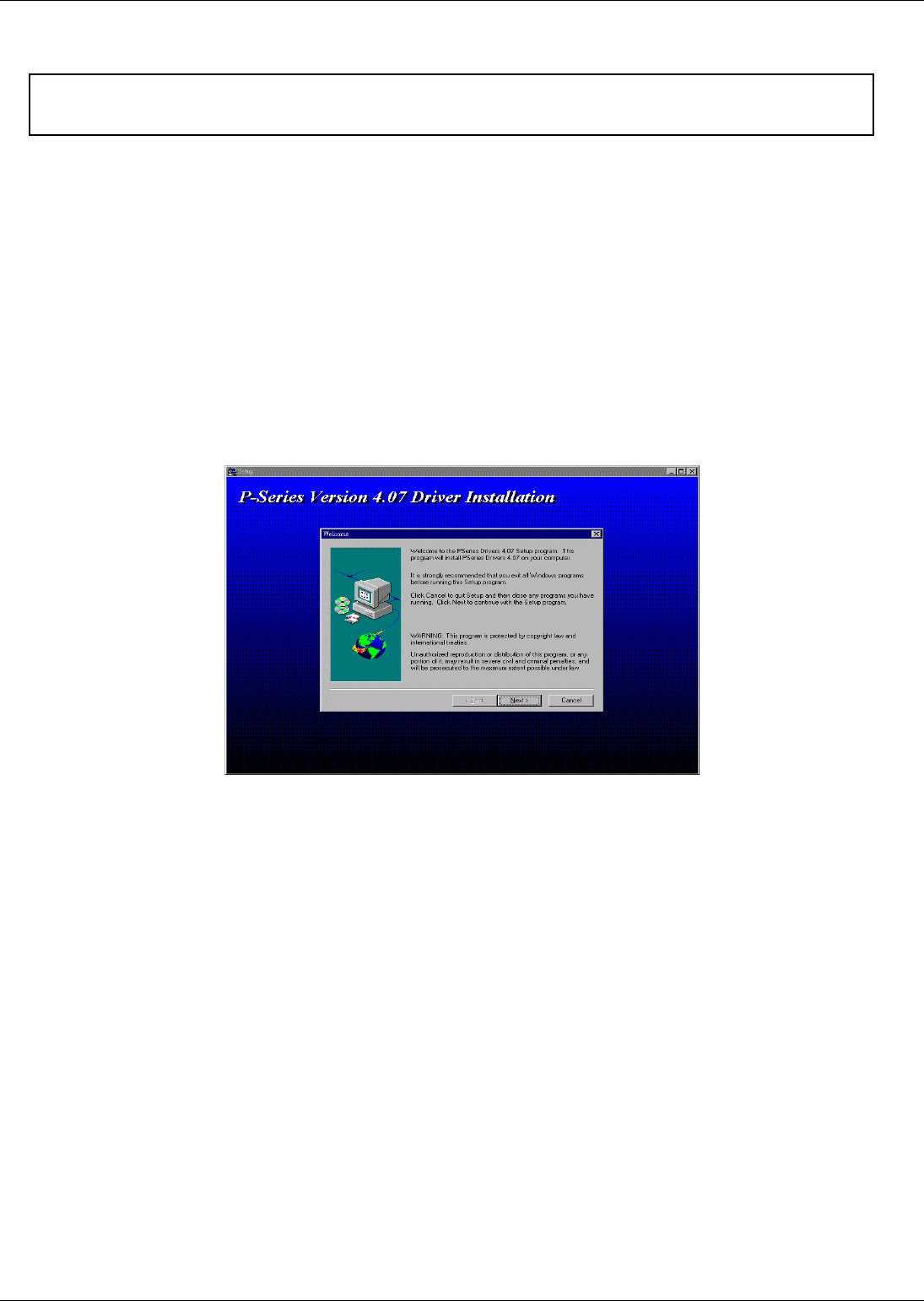
11Mbps Wireless LAN Mini-PCI Card
Page 10 11Mbps Wireless LAN Mini-PCI Card User's Manual
4.2. Installation Procedure for Windows 98
Please follow the following steps one by one in order to install the Mini-
PCI card successfully.
1. Power on your computer and allow Windows 98 to load fully.
2. Be sure that there is no Mini-PCI adapter inserted yet.
3. Insert the given Installation CD in the CD-ROM.
4. Select ELAN (P-Series Driver) and then click on the Setup.
5. Accept the license agreement.
6. It takes a few seconds for copying the utility files and then click on Finish.
7. Restart the PC.
8. Insert Mini-PCI Card in the Mini-PCI slot, and complete setup according to detected instructions.
9. Find Mini-PCI in the CD-ROM and click on the Setup.
Note: Do not insert the Mini-PCI card until you are asked to do so, failure of which may result in unsuccessful installation
of your 11Mbps Wireless LAN Mini-PCI Card card
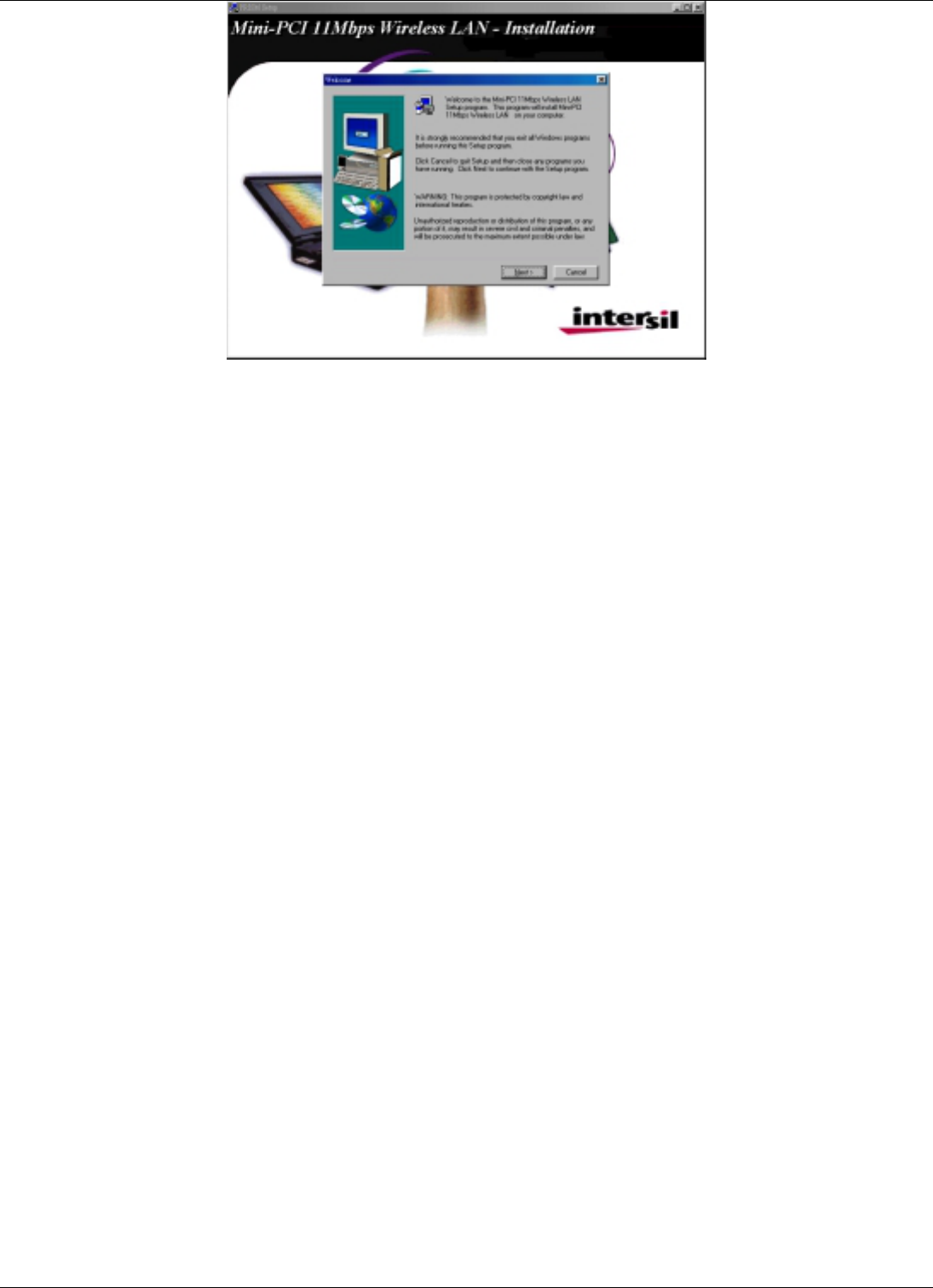
11Mbps Wireless LAN Mini-PCI Card
User's Manual 11Mbps Wireless LAN Mini-PCI Card Page
11
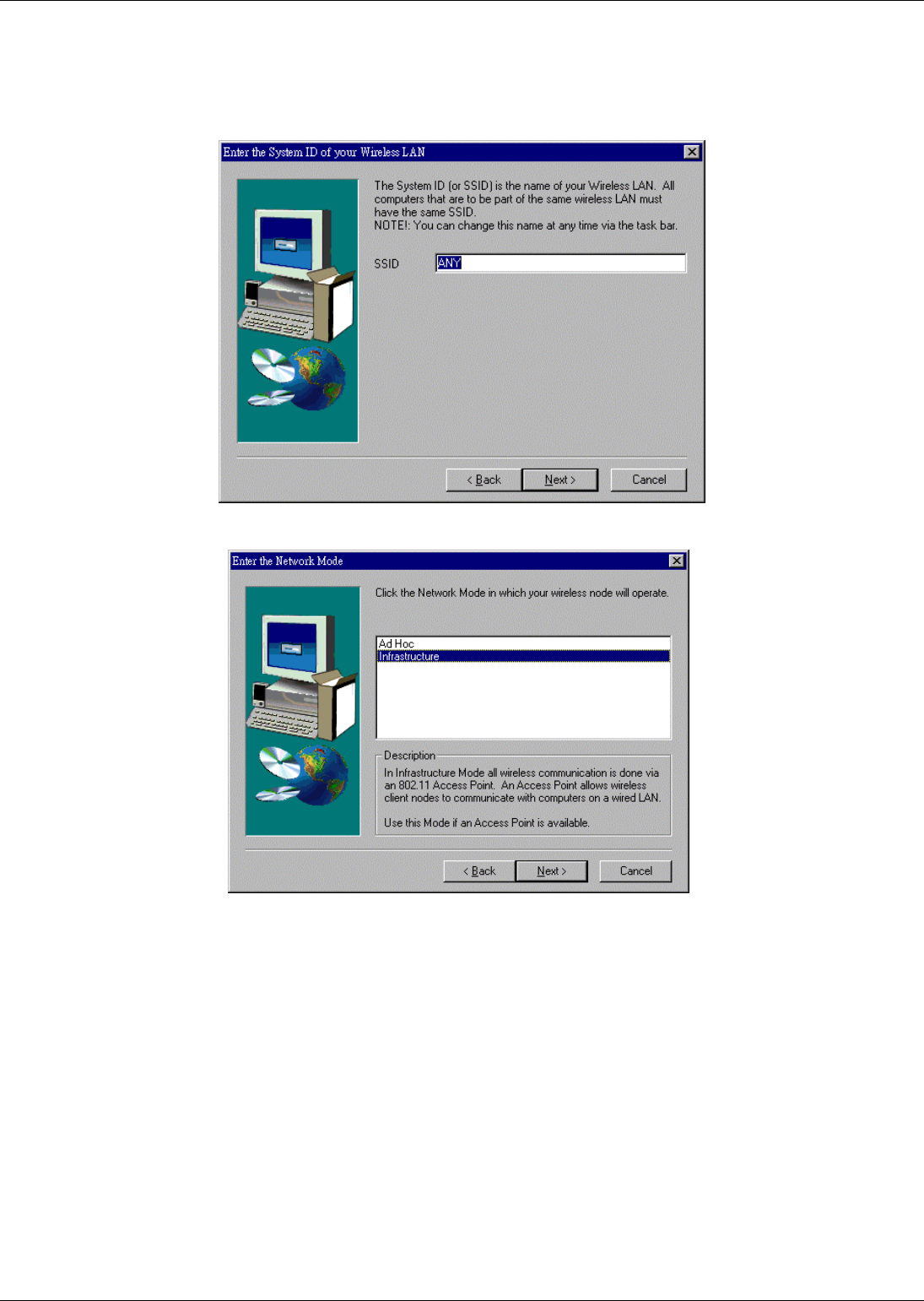
11Mbps Wireless LAN Mini-PCI Card
Page 12 11Mbps Wireless LAN Mini-PCI Card User's Manual
10. Accept the license agreement.
11. Select the SSID. Default ESSID is Default. You can change this later also using the
configuration utility or network configuration. Click on Next.
12. Select network type and click on Next. Default is Infrastructure.
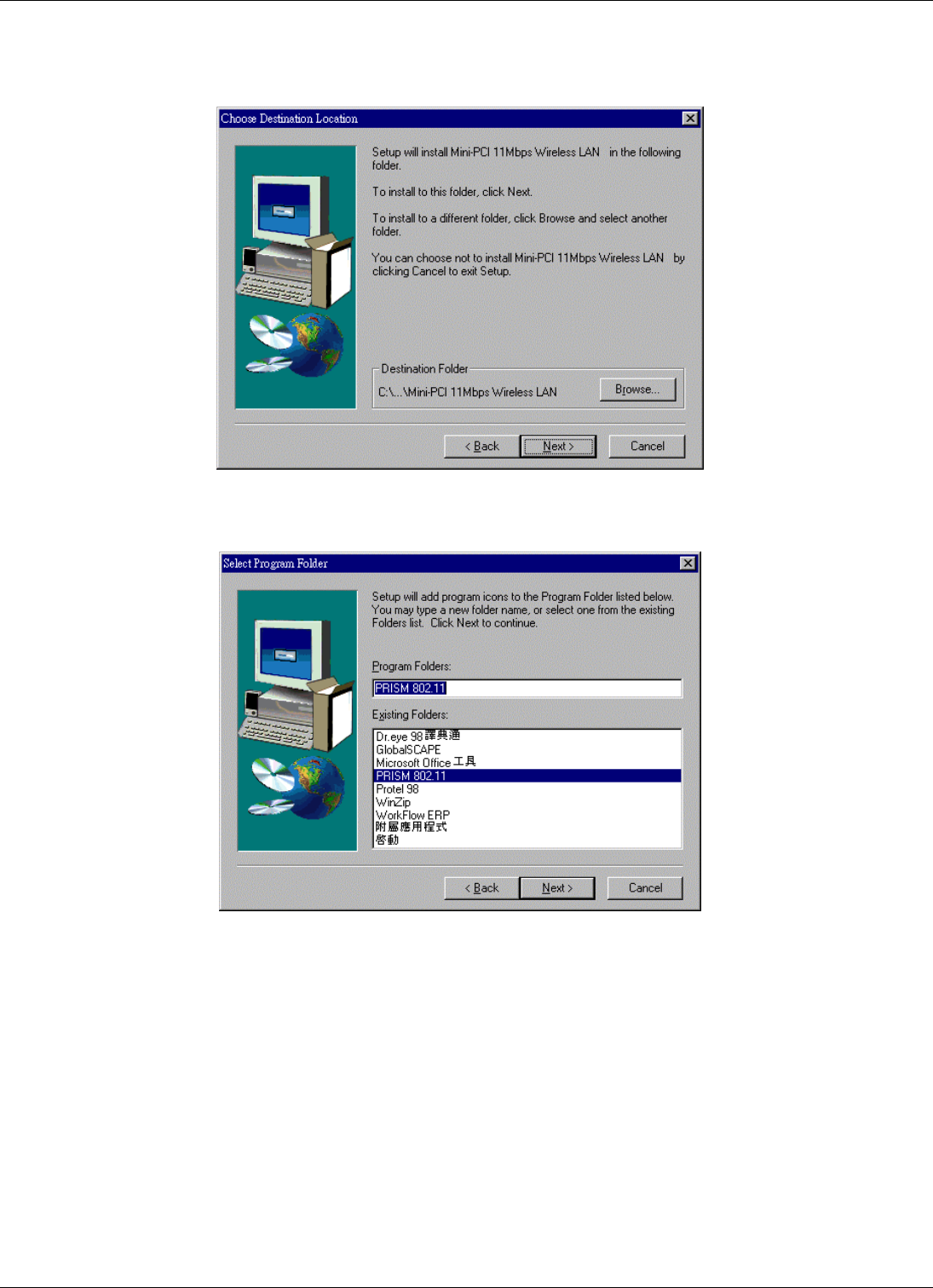
11Mbps Wireless LAN Mini-PCI Card
User's Manual 11Mbps Wireless LAN Mini-PCI Card Page
13
13. Give the path of the destination folder. To set the path of your choice click on Browse and then
click Next.
14. Setup will add program icon to the Program Folder. You may type a new folder name, or select one
from the existing Folder list.
15. It takes a few seconds for copying the utility files and then click on Finish.
16. Restart the PC and Click on the Control Panel and then on PC Card. Check whether it has Mini-PCI
card in one of the sockets or not. If you find 11Mbps Wireless LAN Mini-PCI Card in one of the
sockets, it means the card is detected properly.
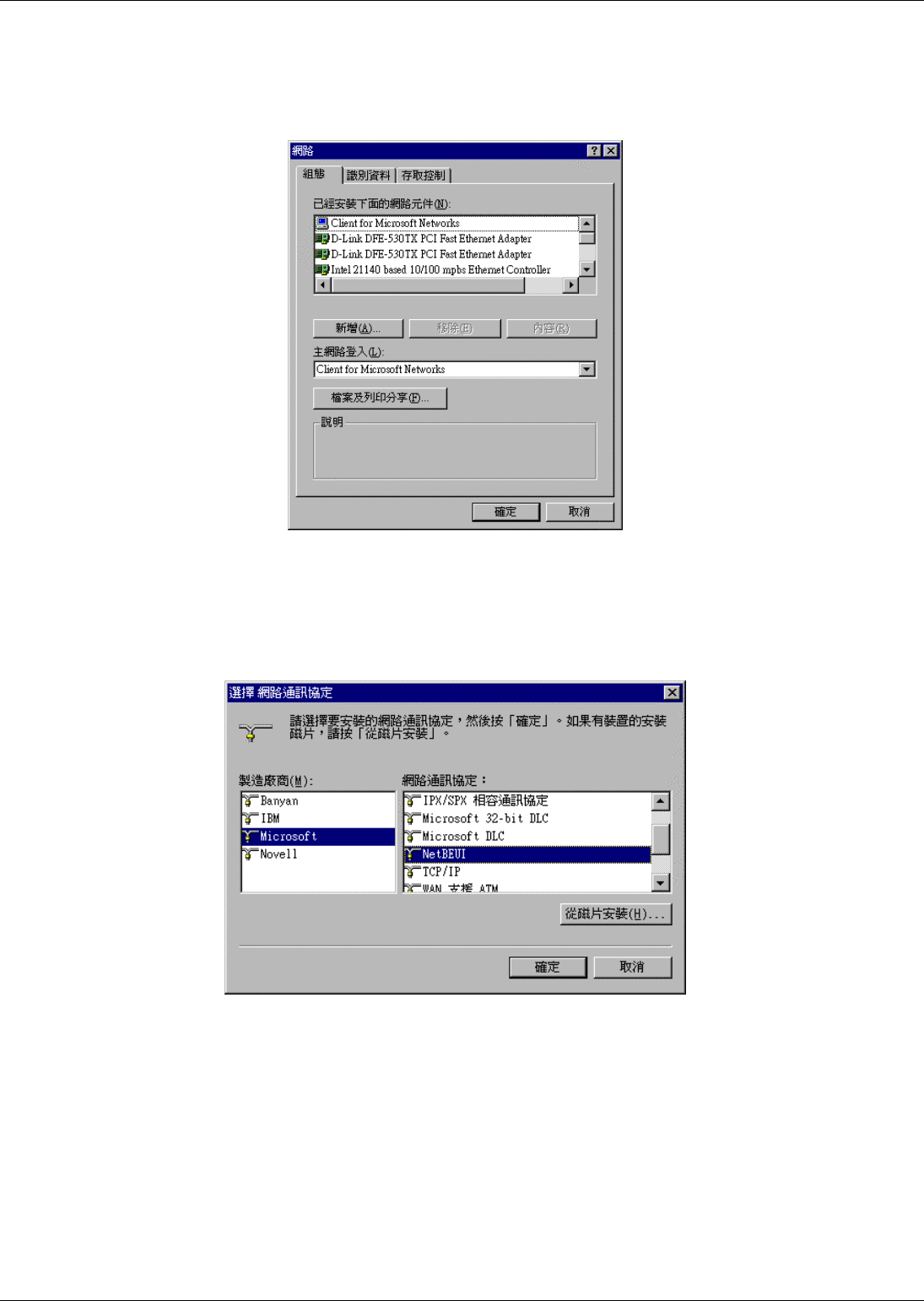
11Mbps Wireless LAN Mini-PCI Card
Page 14 11Mbps Wireless LAN Mini-PCI Card User's Manual
17. Right click on the Network Neighborhood using the mouse.
18. Select Properties from the pop up menu. The network box appears and you see three main tables:
Configuration, Identification, and Access Control.
19. Click on the Configuration tab and then click on the Add button. Select Network Component Type
box appears. Click on the Protocol the click the Add button.
20. Select Network Protocols box appears. From the list of manufactures, click on Microsoft. From the
list of network protocols list, select NetBEUI, then click OK.
21. The NetBEUI protocol is now installed. After clicking on OK return back to Network Component
Type box.
22. Repeat the step 20 and 21 to add IPX/SPX protocol.
23. Repeat the step 20 and 21 to add TCP/IP protocol.
24. Click on the TCP/IP option for setting the IP address for your computer. You can select either Static
or DHCP setting. If you use the static IP setup then enter the IP value, Subnet masking , DNS,
Domain/ Workgroup name, and Gateway Address values. After setting these parameter
appropriately, click OK to return to Network Component Type and you can select the File and
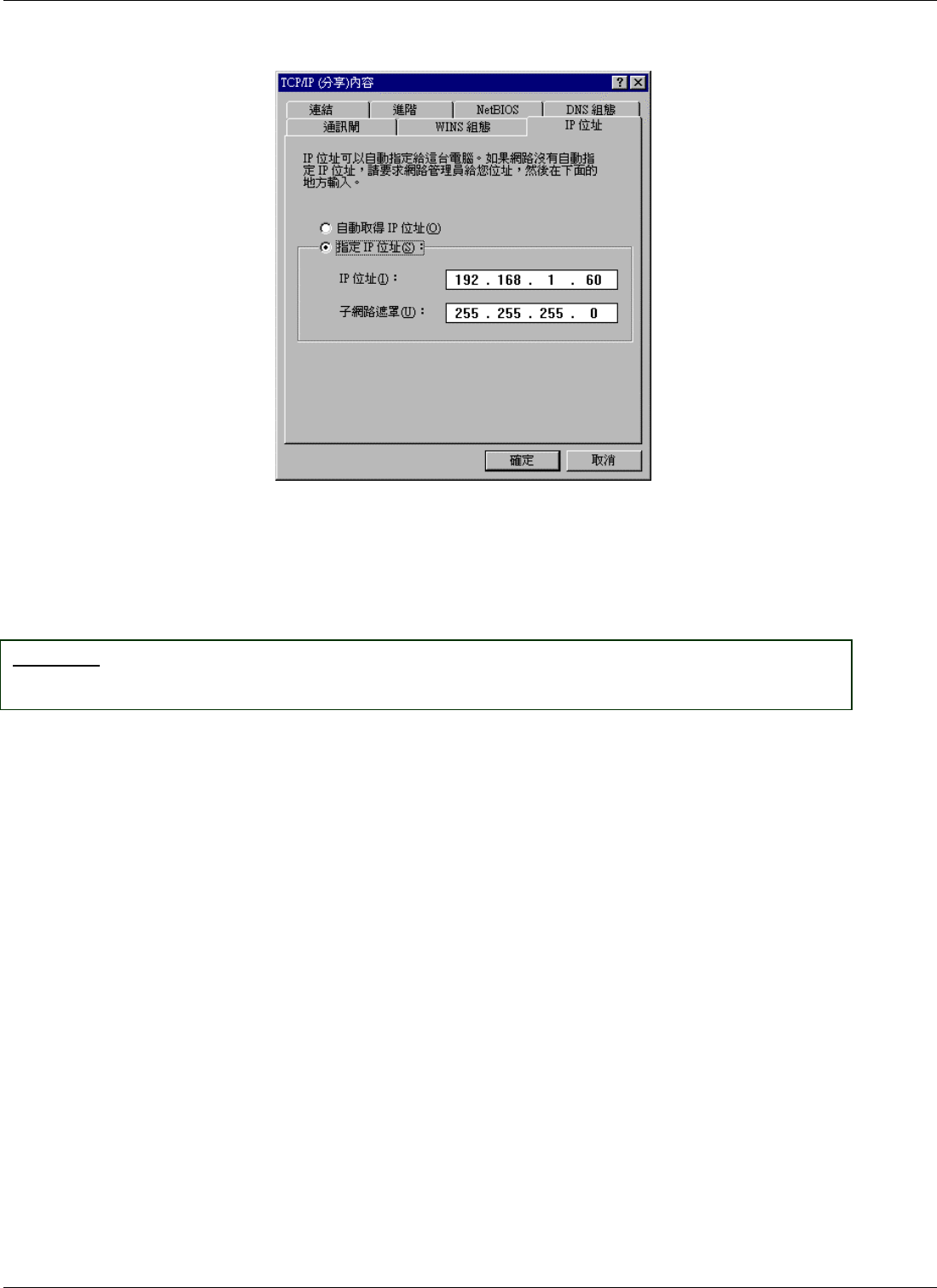
11Mbps Wireless LAN Mini-PCI Card
User's Manual 11Mbps Wireless LAN Mini-PCI Card Page
15
Printer Sharing options as well as the Access to your computer like other users connected to that
network by setting the computer sharing options. Click on OK.
25. Screen message do want to restart your Computer will pop up. Select Yes. It will shut down your
computer and will restart.
Important: Restart your computer to make the changes effective before you reinstall the
driver.
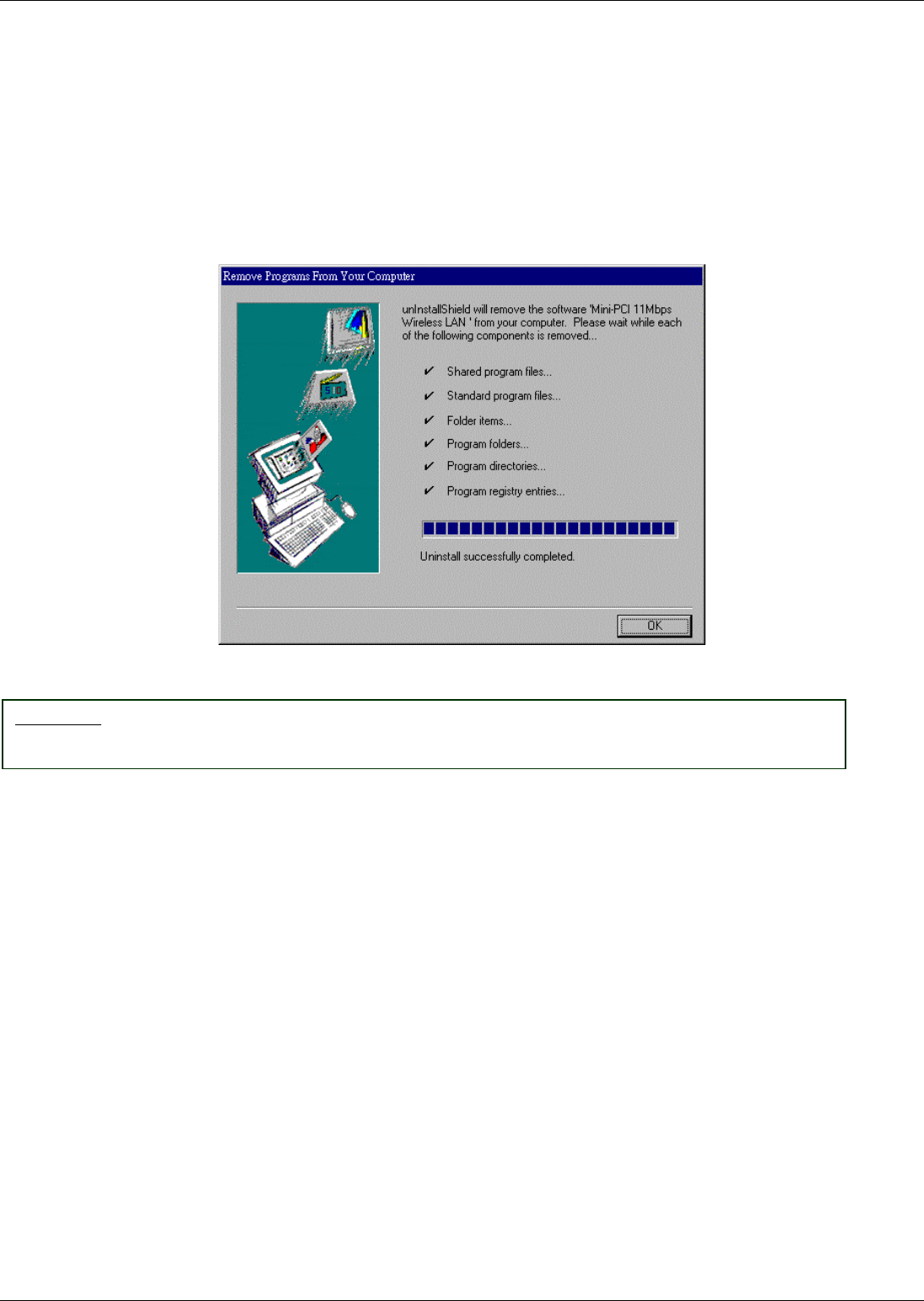
11Mbps Wireless LAN Mini-PCI Card
Page 16 11Mbps Wireless LAN Mini-PCI Card User's Manual
4.3. Uninstallation Procedure for Windows 98
If you want to uninstall the Mini-PCI card under Win 98, click on the Start at the left bottom of your screen.
Select the Programs. Click on the PRISM 802.11 and click on Uninstaller. Confirm message about
removing the " 11Mbps Wireless LAN Mini-PCI Card " and all of its components appear. Click on Yes.
UninstallShield removes the software " 11Mbps Wireless LAN Mini-PCI Card " successfully. Click on OK
to finish the uninstall procedure.
Important: Restart your computer to make the changes effective before you reinstall the
driver.
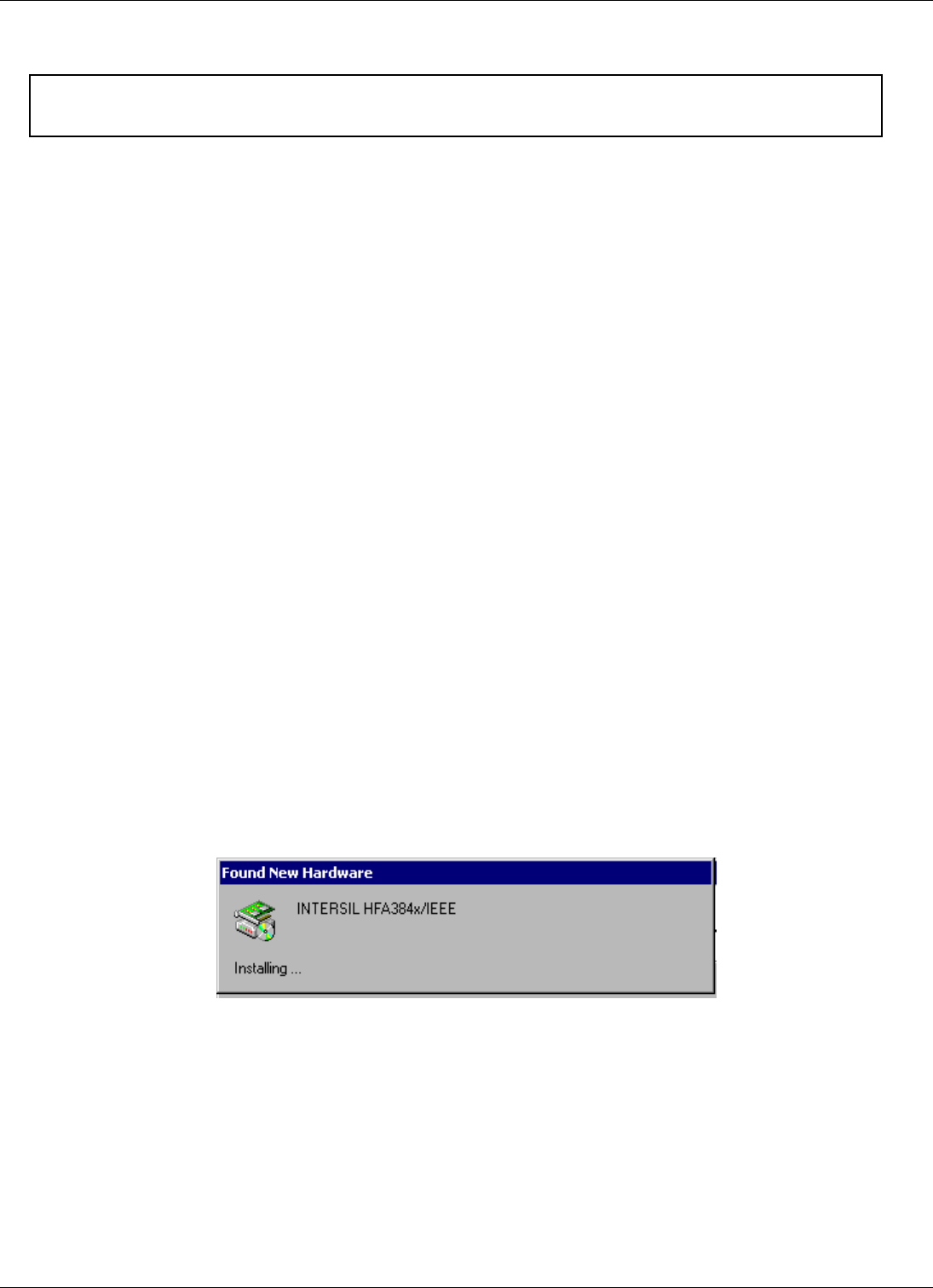
11Mbps Wireless LAN Mini-PCI Card
User's Manual 11Mbps Wireless LAN Mini-PCI Card Page
17
4.4. Installation Procedure for Windows 2000 / Windows ME
Please follow the following steps one by one in order to install the
11Mbps Wireless LAN Mini-PCI Card Card successfully.
1. Power on your computer and allow Windows 2000 / ME to load fully.
2. Be sure that there is no mini-PCI Card inserted yet.
3. Insert the given Installation CD in the CD-ROM and then click on the Setup.
4. Accept the license agreement.
5. Select the SSID. Default ESSID is Default. You can change this later also using the configuration
utility or network configuration. Click on Next.
6. Select network mode and click on Next. Default is Infrastructure.
7. Give the path of the destination folder. To set the path of your choice click on Browse and then
click Next.
8. Setup will add program icon to the Program Folder. You may type a new folder name, or select one
from the existing Folder list.
9. It takes a few seconds for copying the utility files and then click on Finish.
10 Then insert 11Mbps Wireless LAN Mini-PCI Card Card into the slot, wizard will found new
hardware “11Mbps Wireless LAN Mini-PCI Card Card”, click on Next.
11 Choose “Search for a suitable driver for my device”, and then click on Next.
12 Select CD-ROM drives to locate driver files. And click on Next.
Note: Do not insert the Mini-PCI card until you are asked to do so, failure of which may result in unsuccessful installation
of your 11Mbps Wireless LAN Mini-PCI Card card
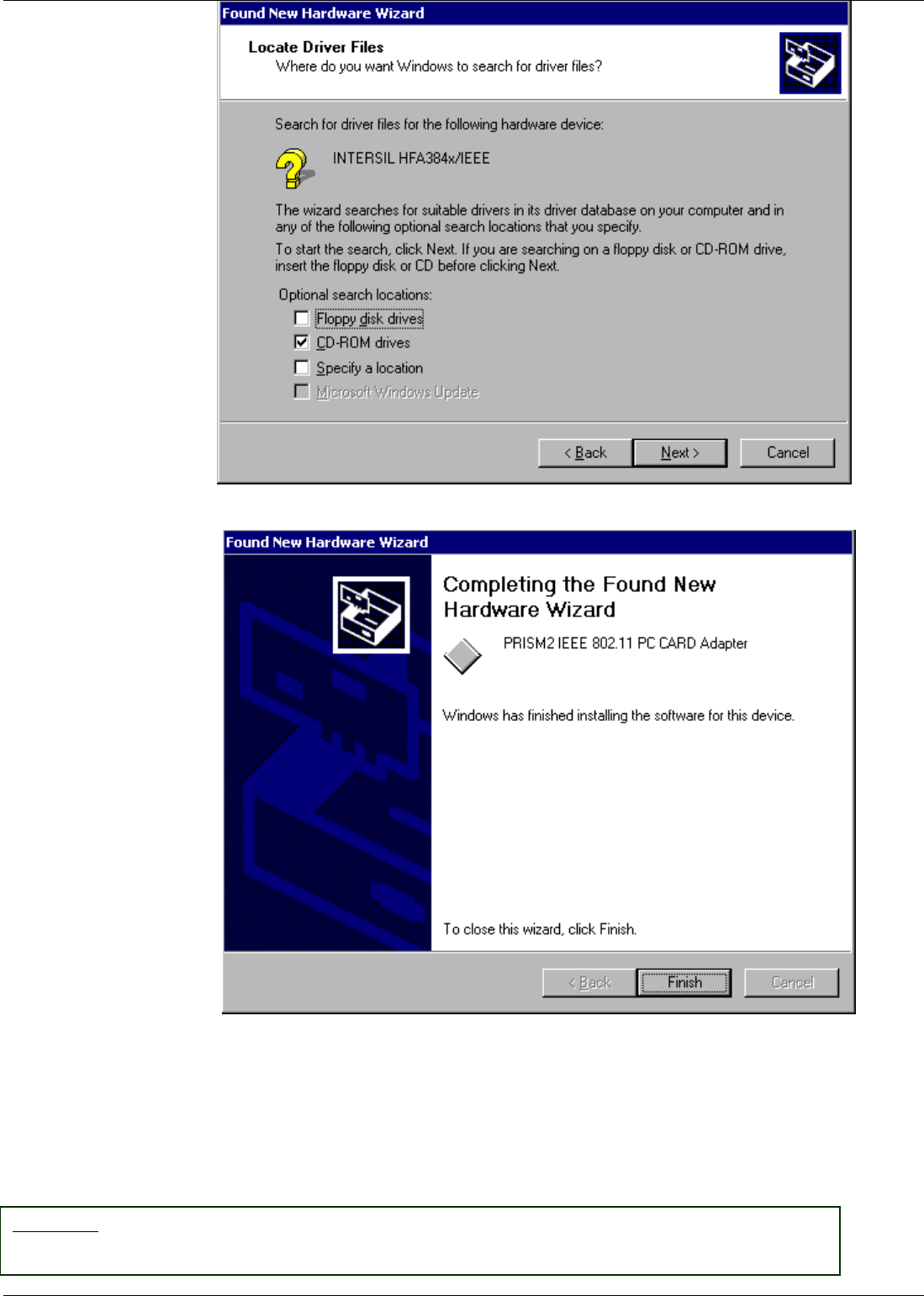
11Mbps Wireless LAN Mini-PCI Card
Page 18 11Mbps Wireless LAN Mini-PCI Card User's Manual
13 Complete the installation and the restart your computer.
14 If your 11Mbps Wireless LAN Mini-PCI Card Card is install properly, then right click on the My
Network Place using the mouse, click Properties to set up local area connection.
15 Set Internet protocol (TCP/IP), either choose obtain an IP address automatically or set your own
IP address. Then click OK.
16 Restart your Computer
Important: Restart your computer to make the changes effective before you reinstall the
driver.

11Mbps Wireless LAN Mini-PCI Card
User's Manual 11Mbps Wireless LAN Mini-PCI Card Page
19
4.5. Uninstallation Procedure for Windows 2000/Windows ME
If you want to uninstall the Mini-PCI card under Win 98, click on the Start at the left bottom of your screen.
Select the Programs. Click on the PRISM 802.11 and click on Uninstaller. Confirm message about
removing the " 11Mbps Wireless LAN Mini-PCI Card " and all of its components appear. Click on Yes.
UninstallShield removes the software " 11Mbps Wireless LAN Mini-PCI Card " successfully. Click on OK
to finish the uninstall procedure.
Important: Restart your computer to make the changes effective before you reinstall the
driver.
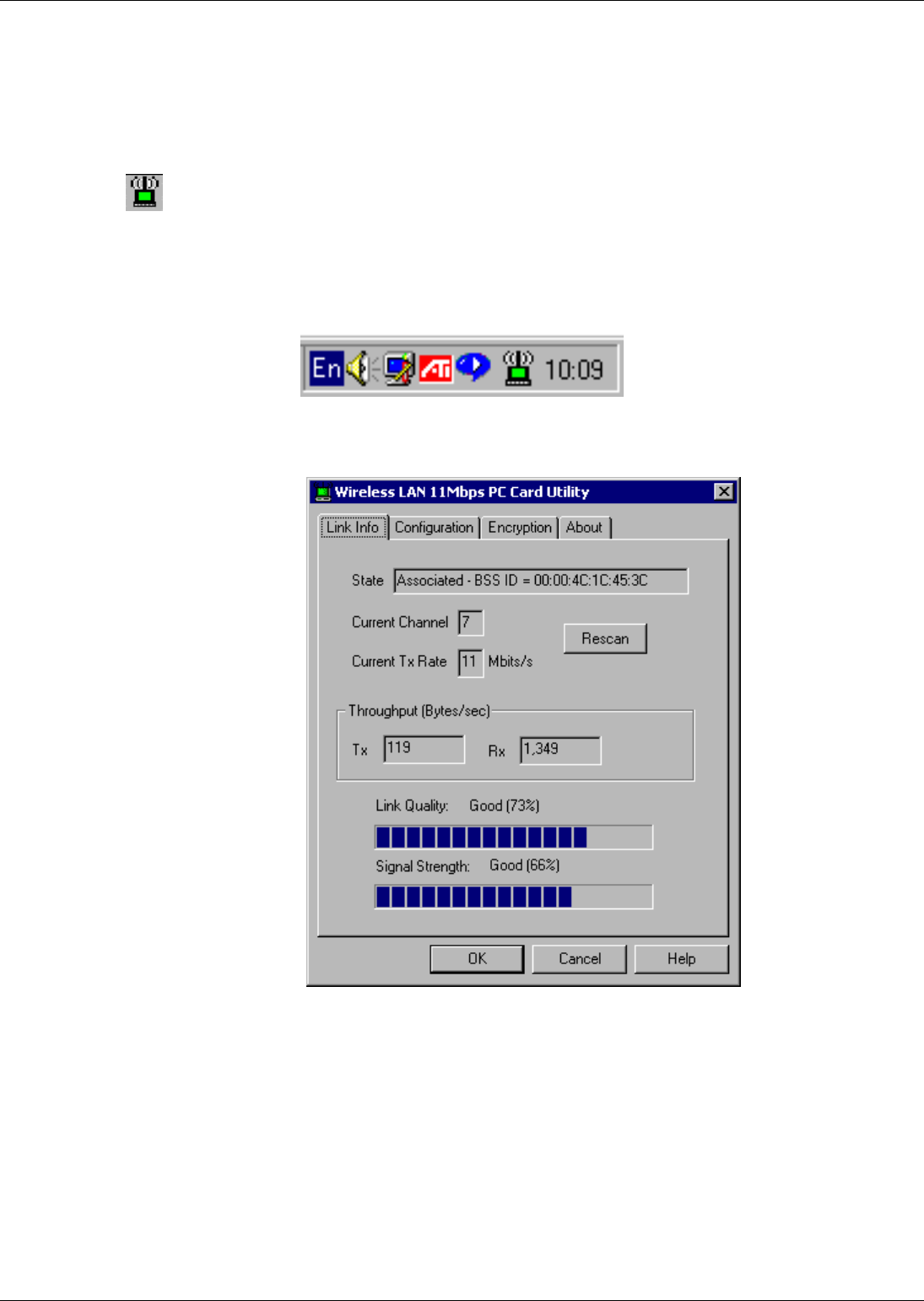
11Mbps Wireless LAN Mini-PCI Card
Page 20 11Mbps Wireless LAN Mini-PCI Card User's Manual
5. Configuration Utility
11Mbps Wireless LAN Mini-PCI Card adapter uses its own management software. All functions
controlled by user are provided by this application. Usually this application starts automatically, Use
Start, Programs, 11Mbps Wireless LAN Mini-PCI Card to start the Manager application.
A new icon - should appear in your Icon tray. If the icon is marked with a red “X”, it means that
11Mbps Wireless LAN Mini-PCI Card NIC configuration is invalid or incomplete. Sometimes icon can
be colored in red. This can happen when driver is in Pseudo BSS mode, and the radio channel, which
is used for communication is defined incorrectly.
Figure 1 Icon tray with a new icon
Double clicking on that icon will show you the screen as shown below.
Figure 2 Management window with “Status” tab open
User can navigate through “sheets”, by clicking or tapping them with a stylus. “OK” button will minimize
window, and “Exit” (or X button) will close application. Here we explain the use and meanings of the
various screen messages.

11Mbps Wireless LAN Mini-PCI Card
User's Manual 11Mbps Wireless LAN Mini-PCI Card Page
21
Link Info
- State
This field is used to display the current state of the driver. When the state is “Associated “ means
normal flow of operation in Infrastructure mode. The Notebook is connected to access point.
BSSID is shown in the form of hex digits. Networking is available.
A state of “Scanning ” means that the node is searching for available access point and can not
detect the SSID for an access point within range.
This field will also display an error message if for some reason the driver failed to initialize.
- Rescan
Pressing the rescan button causes the driver to restart and begin its Connection Procedure. The
connection procedure differs depending on the Mode of the driver.
Infrastructure Mode - The driver will Scan all available channels continuously until it finds one or
more Access Points that matches its SS ID. At that point it will try and authenticate and associate
with the Access Point.
Ad Hoc Mode - The driver will scan for 5 seconds looking for an existing Ad Hoc network using
the same SS ID. If one is not found the driver will “Start” its own Ad Hoc network.
- Current Channel and Tx Rate
Shows the channel of the radio and transmit rate are being currently used for an active connection.
This value has no meaning when the radio is “Scanning”
- Throughput
These two fields display the instantaneous wireless Receive and Transmit throughput displayed in
bytes per second. These values are updated every two seconds.
- Link Quality
The Link Quality bar graph is only active when the node is in Infrastructure Mode. The bar graph
displays the quality of the link between the node and its Access Point. A label summarizes the
quality of the link over the bar graph, which can take on one of the following values:
“Not Applicable”
“Poor”
“Fair”
“Good”
“Excellent”

11Mbps Wireless LAN Mini-PCI Card
Page 22 11Mbps Wireless LAN Mini-PCI Card User's Manual
The driver will start looking for a better Access Point if the Link Quality becomes “Poor”. Link Quality
is a measure of receive and transmit errors over the radio.
- Signal Strength
The Signal Strength bar graph is only active when the node is in Infrastructure Mode. The bar
graph displays normalized signal strength as reported by the radio, averaged over all frames over
100 bytes long that are received from the Access Point.
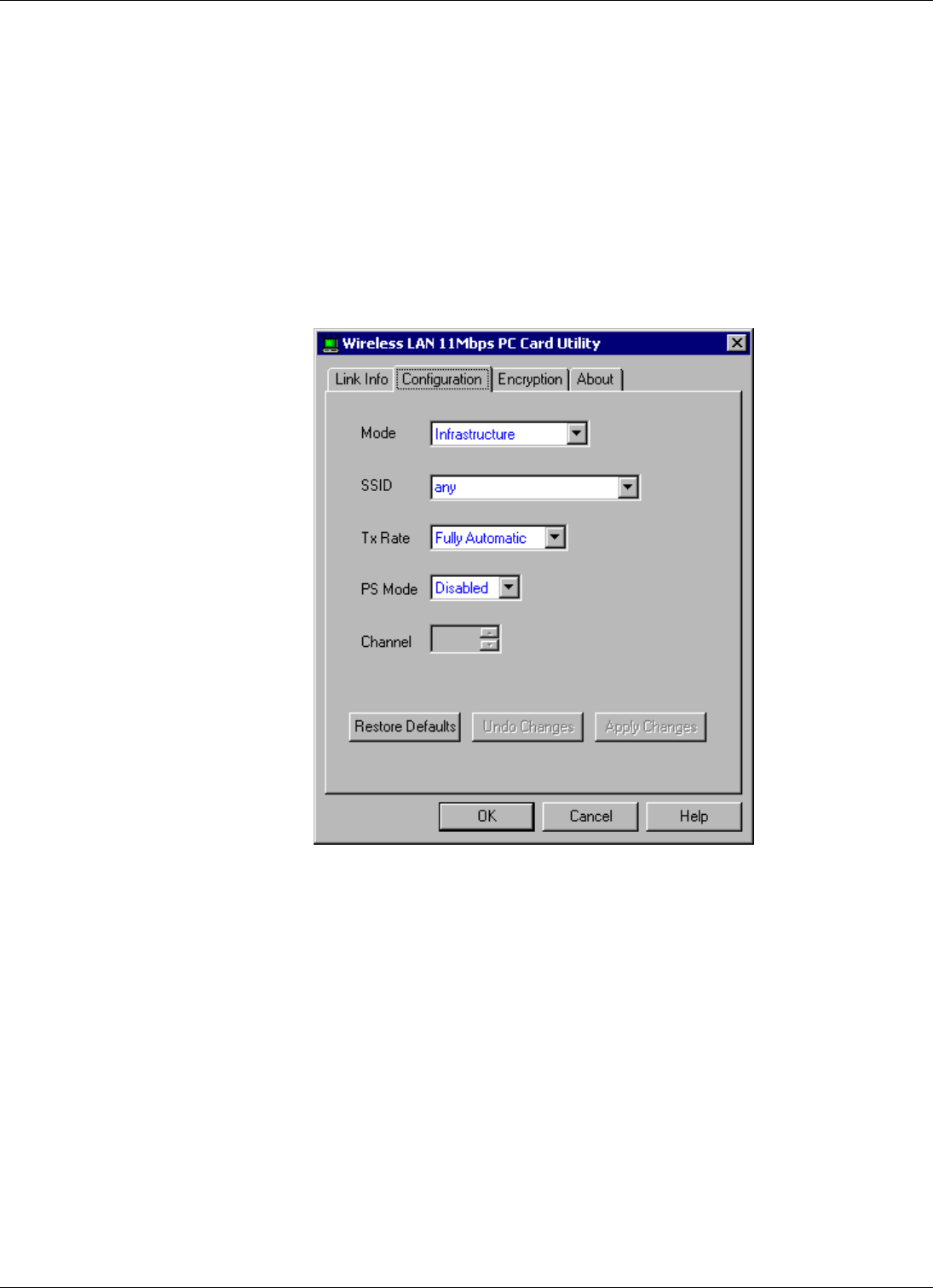
11Mbps Wireless LAN Mini-PCI Card
User's Manual 11Mbps Wireless LAN Mini-PCI Card Page
23
“CONFIGURATION” tab
The Configuration Tab contains several fields where operating
parameters of the driver can be viewed or changed. Changes to any of
the parameters in this panel can be applied to the driver without the
need to reboot the Notebook.
Figure 4 Management window with "CONFIGURATION" tab open
Restore Defaults:Pressing this button restores each field in the panel to its default value. The Apply
Changes button or OK must be pressed before the default values are saved to the
driver and registry.
Undo Changes: Pressing this button reverts all fields in the panel back to their original values that
were present when the Configuration Utility was opened from the Task Bar.

11Mbps Wireless LAN Mini-PCI Card
Page 24 11Mbps Wireless LAN Mini-PCI Card User's Manual
Apply Changes: This button becomes active only when one of the fields has been modified. Pressing
this button applies the changed values to the driver and saves them to the registry
for the next time the Notebook boots up.

11Mbps Wireless LAN Mini-PCI Card
User's Manual 11Mbps Wireless LAN Mini-PCI Card Page
25
- Mode
This field allows you to select from a list of supported Network “Modes”. The modes displayed will
have three values: “802.11Ad Hoc”, “ Ad Hoc”, and “Infrastructure”.
802.11 Ad Hoc - This is the 802.11 peer-to-peer mode of operation. In 802.11Ad Hoc only one
wireless “cell” is supported for each different SSID. All communication is done from Client to Client
without the use of an Access Point. 802.11 Ad Hoc networking use the same SSID for establishing
the wireless connection.
Ad Hoc - A non-compliant mode that will allow Prism2 (and only Prism2) cards to talk with one
another without an AP regardless any SSID. Since it is not standards compliant, It would have the
interpretability with non-Prism2 radios.
Infrastructure - This mode of operation requires the presence of an 802.11 Access Point. All
communication is done via the Access Point, which relays packets to other wireless Clients in
the BSS as well as to nodes on a wired network such as Ethernet.
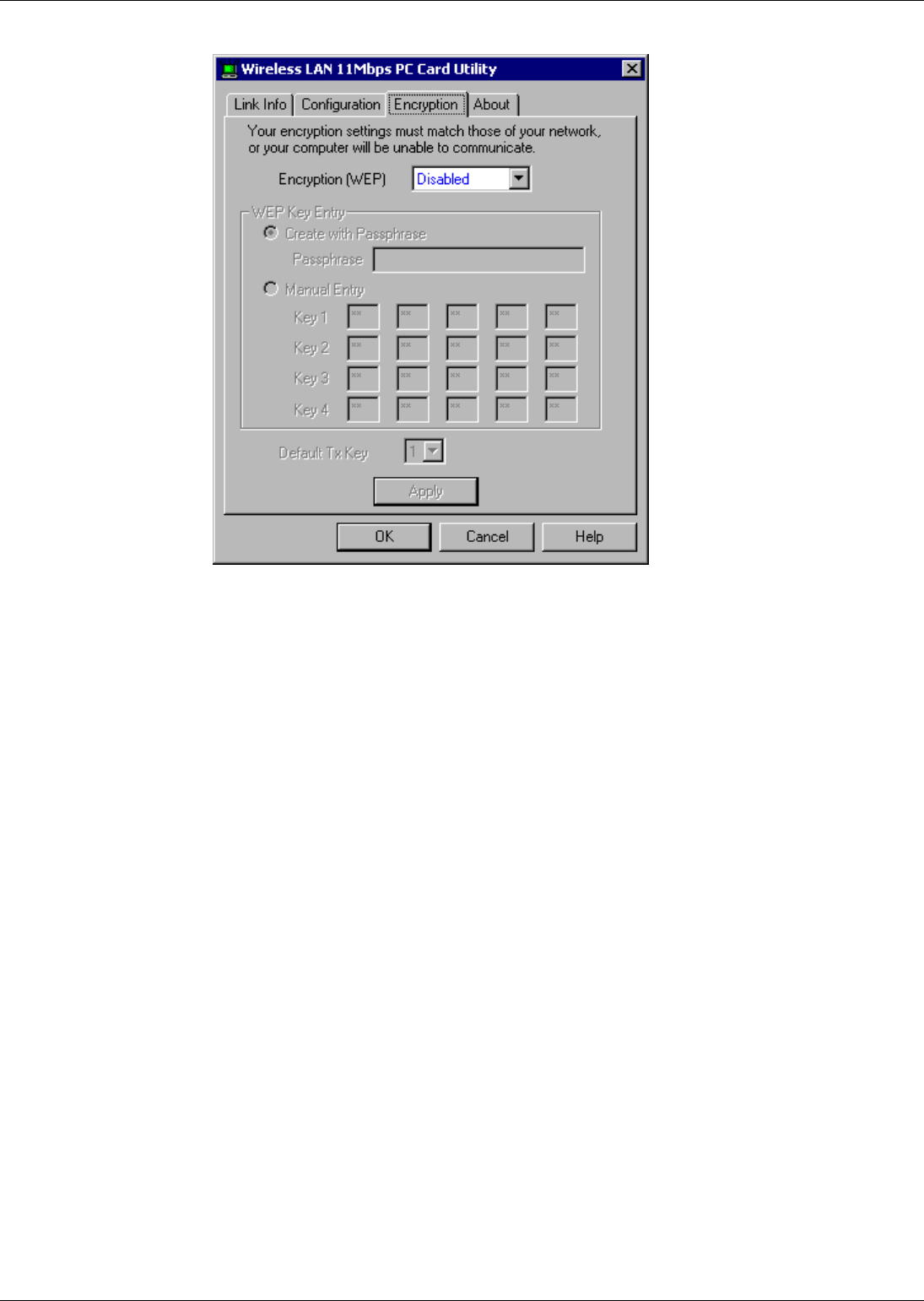
11Mbps Wireless LAN Mini-PCI Card
Page 26 11Mbps Wireless LAN Mini-PCI Card User's Manual
“ENCRYPTION” tab
Figure 5 Management window with “Encryption” tab open
You may desire an additional measure of security on your wireless network, which can be
achieved by using WEP (Wired Equivalent Privacy) encryption. WEP encrypts each frame
transmitted from the radio using one of the Keys entered from this panel.
When an encrypted frame is received it will only be accepted if it decrypts correctly. This will only
happen if the receiver has the WEP Key used by the transmitter.
This panel allows the entry of four keys for 64-bit encryption and one set of 128-bit key according
to WEP function select. To be written to the driver and registry, each key must consist of hex digits,
which means that only digit 0-9 and letters A-F are valid entries. If entered incorrectly program will
not write keys to a driver.
Alternatively a Pass-phrase can be entered which is used as a “seed” to randomly generate the
four keys. This saves considerable time since the same keys must be entered into each node on
the wireless network.

11Mbps Wireless LAN Mini-PCI Card
User's Manual 11Mbps Wireless LAN Mini-PCI Card Page
27
- Key 1 – Key 4
These four fields can be used to manually enter the keys. This may be necessary if you wish
this node to match keys in a different vendor’s product. These fields also display the keys when
they are generated using a Pass-phrase.
- Default Tx Key
This button updates the driver with the four keys displayed in Key1 through Key4. The keys are
also written to the registry for permanent storage. For 128 bit encryption, this button will be
invisible.
- Apply
This button updates the driver with the four keys displayed in Key field. The keys are also
written to the registry for permanent storage. This button clears all the bytes in the four keys,
useful when manually entering and you wish to start over.
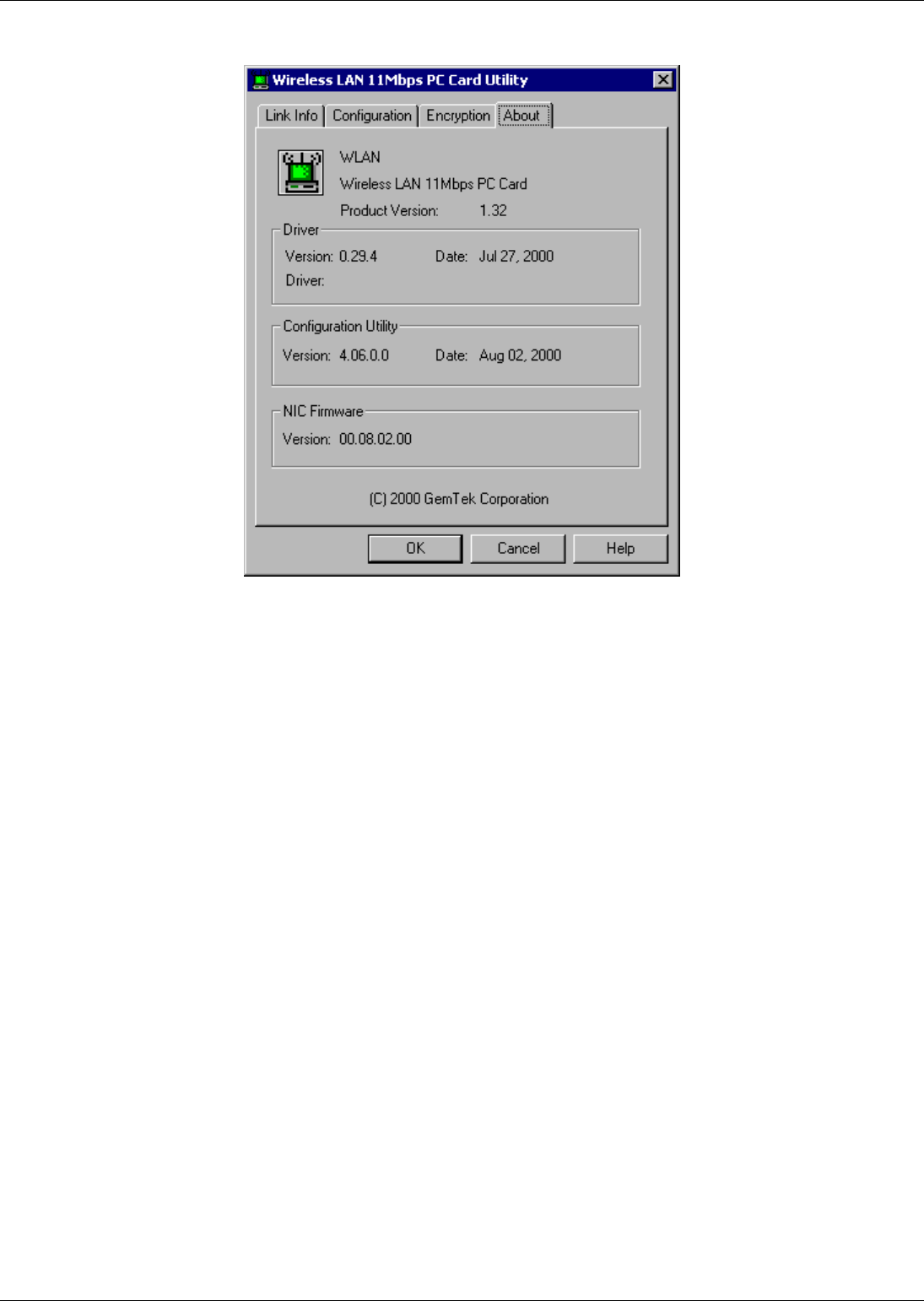
11Mbps Wireless LAN Mini-PCI Card
Page 28 11Mbps Wireless LAN Mini-PCI Card User's Manual
“ABOUT” tab
Figure 6 Management window with "ABOUT" tab open
About tab shows the product version including the detail of Driver, Configuration Utility, and NIC
firmware version. Users must use this version number when reporting their problems to tech support.

11Mbps Wireless LAN Mini-PCI Card
User's Manual 11Mbps Wireless LAN Mini-PCI Card Page
29
6. Troubleshooting
To make the installation of 11Mbps Wireless LAN Mini-PCI Card Card more users friendly, we have
suggested following the installation steps one by one as listed in the section 4 and section 5. Still you
encounter some problems while installing the 11Mbps Wireless LAN Mini-PCI Card Card or you
want to confirm whether your card is installed properly or not, we have listed the procedure for
checking the various components after you have installed the card. In first part of Troubleshooting,
we have suggested the users to check the various properties of the card to check the proper
installation. In second section, we have listed the various problems that you may encounter during the
installation and have also listed the possible solution. Check the first part to guess the probable
reason of unsuccessful installation.
Procedure to Check the Various Properties of Card after Installation under Windows 98:
Please check the followings if you encounter some problem while installing the Mini-PCI card or your
Mini-PCI card is non-functional.
1. Click on the Control Panel and then on Mini-PCI Card. Check whether it has Mini-PCI card in
one of the sockets or not. If you find 11Mbps Wireless LAN Mini-PCI Card Card in one of the
sockets, it means the card is detected properly. If you see the Yellow sign of Question-mark (?),
the resources are conflicting.
2. Right click on My Computer and the select Properties. Select the Device Manager and click
on the Network Adapter. You will find 11Mbps Wireless LAN Mini-PCI Card Card if it is
installed successfully. If you see the Yellow sign the resources are conflicting. Click on Mini-
PCI Card and then on Mini-PCI Card Service, you can see the status of Mini-PCI card. If there
are yellow sip either on adapter or Mini-PCI card, please check the followings.
1. Check if your Notebook supports 3.3V Card.
2. Check if your Notebook has a free IRQ. If not, make an IRQ free by assigning
the same IRQ to some devices, for example COM 1, COM 2 can be assigned same
IRQ values.
3. Check that you have inserted the right card and have installed the proper driver.

11Mbps Wireless LAN Mini-PCI Card
Page 30 11Mbps Wireless LAN Mini-PCI Card User's Manual
For the Card under Windows 2000:
Please check the followings if you encounter some problem while installing the Mini-PCI card or your
Mini-PCI card is non-functional.
1. Check the Windows 2000 Diagnostics. You should find out whether there is any conflict
in the resource allocation or the I/O address, IRQ allocations. If you find that the IRQ or
I/O addresses are already assigned to some other devices, you must change that value.
I/O address needs 40h byte length.
2. Click on the Control panel. Double click on the Mini-PCI Card, you will see 11Mbps
Wireless LAN Mini-PCI Card Card . Double clicking on that will show you the Card
Information, driver name and the driver file. You must confirm the name of the driver and
the driver file as "cw10" and "cw10.sys". If you do not find the names as we listed before,
there are some problems and the driver is not installed properly. Reinstall the driver.
Note: Check the PnP BIOS setup menu and select no in case of the 11Mbps Wireless LAN
Mini-PCI Card Card installation.

11Mbps Wireless LAN Mini-PCI Card
User's Manual 11Mbps Wireless LAN Mini-PCI Card Page
31
7. Technical specifications of 11Mbps Wireless LAN Mini-PCI Card Card
WL250F Specification
Product Name 11 Mbps Wireless LAN mini PCI card
Model Number WL-250F
Host Interface MINI PCI Type III A
Dimensions 59.75 x 50.95 x 5 mm
Weight 19 g
Frequency Band 2.400 ~ 2.4835GHz (subject to local regulations)
USA and Canada – 11 Most European countries - 13Number of Channel France – 4 Japan – 13 (optional 14)
Operating Voltage 3.3V
Spreading DSSS (Direct Sequence Spread Spectrum)
Data rate 11Mbps, 5.5Mbps, 2Mbps, 1Mbps
Transmit Power 13 dBm
Receive Sensitivity 11 Mbps10-5 BER @ -81 dBm, minimum
Modulation 11Mbps and 5.5Mbps CCK; 2Mbps: DQPSK;1Mbps: DBPSK;
Security 40-bit WEP Encryption
Antenna UFL connector
LED indicator None, or optional
Driver Windows 98/2000, NT 4.0, WIN CE, Linux
Standards IEEE 802.11b, WI-FI compliant
Media Access Protocol CSMA/CA with ACK
Warranty 1 year, optional 3 years
Temperature Range 0 ~ 50°C (Operating), -20~70°C (Storing)
Humidity Max. 95% Non-condensing
Operating Range Open Space: 100 – 300m; Indoor: 35m – 100m
Roaming Full mobility and seamless roaming from cell to cell and across access points
(subject to access point)
Network Protocol TCP/IP, IPX, NDIS3, NDIS4
Management Utility Link Config for network join and diagnostics
EMC certification FCC part 15 class in US, ETSI 300.328 and CE EMC-EEC in Europe, and
ARIB-Telec in Japan
Packaging Generic, built-in

11Mbps Wireless LAN Mini-PCI Card
Page 32 11Mbps Wireless LAN Mini-PCI Card User's Manual
Features Benifits
Reliable Performance Without Wires
Load balancing PC Cards, PCI cards, USB cards and mini-PCI cards
automatically switch to the best available Access Point when
the current Access Point becomes congested or the signal
weakens. This ensures uninterrupted access to network
services and optimum data rates.
Dynamic rate shifting Points dynamically support 11,5.5,2,and 1 Mbps for
maximum availability and reliability of network connections.
The proper data rate is determined automatically, based on
signal strength.
Antenna diversity All Gemtek WLAN products feature antennae with signal
diversity. Each product has two antennae to improve the
likelihood of strong signal reception
S
tandards-based
IEEE802.11b- and -Wi-Fi –compliant Gemtek SparkLAN products comply with IEEE802.11b at
1,2,5.5,and 11 Mbps. They offer backwards compatibility
with the original 802.11 standard at 1 and 2 Mbps,
interoperating with other Direct Spread Spectrum products.
The SparkLAN wireless LAN solution is also Wi-Fi certified.